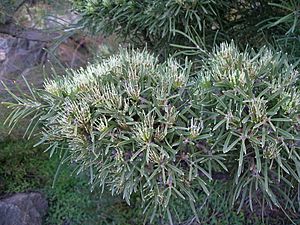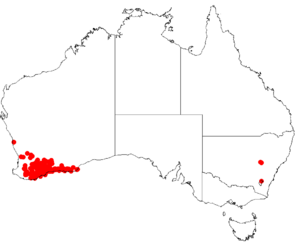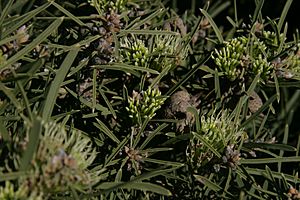Cauliflower hakea facts for kids
Quick facts for kids Cauliflower hakea |
|
|---|---|
 |
|
| Scientific classification | |
| Genus: |
Hakea
|
| Species: |
corymbosa
|
 |
|
| Occurrence data from Australasian Virtual Herbarium | |
The Hakea corymbosa, often called the cauliflower hakea, is a cool plant from the Proteaceae family. It grows naturally in the south-west part of Western Australia. This plant is a very prickly bush, but it has sweet-smelling yellowish flowers. Its dense, spiky shape and flowers full of nectar make it a great home and food source for local wildlife.
Contents
What Does the Cauliflower Hakea Look Like?
The Hakea corymbosa is a shrub that grows upright and has many branches. It can reach about 0.5 to 2 metres (1.6 to 6.6 ft) tall and 2.5–3 m (8–10 ft) wide. When the plant is young, its new shoots are called "water canes." As they grow, they form new groups of leaves.
This shrub becomes very thick and prickly. Its leaves look like fluffy "clouds" clustered together. The leaves are narrow and waxy, about 2.5 to 12 cm (1.0 to 4.7 in) long. They are arranged along the stems, but they form a circle (a whorl) near the flowers. Each leaf has a clear vein on top and three veins underneath, ending in a sharp point.
The plant produces many flowers, usually 12 to 18 in a cluster. These clusters appear where the leaves meet the stem. The small stalks holding the flowers (called pedicels) are about 3.5–5 mm (0.1–0.2 in) long and smooth. The flower petals (called the perianth) are a pale yellow-green color.
After flowering, the plant grows woody fruits. These fruits have a rough feel and are shaped like a broad egg. They are about 2 to 3 centimetres (0.8 to 1.2 in) long and 1.5 cm (0.59 in) wide, ending in a short, sharp point. Inside, the seeds have wings and are about 12–17 mm (0.47–0.67 in) long and 6.5–11 mm (0.26–0.43 in) wide.
How Was the Cauliflower Hakea Named?
The Story Behind the Name
The Hakea corymbosa was first officially described by a botanist named Robert Brown in 1830. He included it in his book Supplementum primum prodromi florae Novae Hollandiae. The first plant sample used for this description was collected by William Baxter in 1823 at King George Sound.
The second part of its scientific name, (corymbosa), comes from the Latin word corymbus. This word means "bunch of flowers," "peak," or "top." It refers to how the flowers grow in a flat-topped or rounded shape.
There was another type of Hakea with bright yellow flowers found north of Perth. It was once thought to be the same plant, but it was later classified as a separate species called Hakea eneabba.
Where Does the Cauliflower Hakea Grow?
Natural Home and Environment
The Hakea corymbosa is native to several regions in Western Australia. You can find it in the Great Southern, southern Wheatbelt, and Goldfields-Esperance areas. Its range stretches from Williams in the west to Cape Arid in the east. It also grows from Albany in the south up to Kondinin in the north.
This plant prefers sandy soils that can be a bit acidic or slightly alkaline. It often grows where there is laterite (a type of soil rich in iron and aluminum) or granite rocks. You can find it in open heathlands or in woodland areas.
How Can We Use the Cauliflower Hakea?
Growing This Plant in Gardens
The Hakea corymbosa can be grown in gardens in a sunny spot. It can grow in most types of soil. It prefers places with a mild climate that get more than 400 mm (16 in) of rain each year. If planted in a shady spot, the plant might grow longer and thinner.
This plant is great for several uses in a garden. It can be planted to block wind, create a hedge, or help stop soil from washing away (erosion control). The Hakea corymbosa is also highly recommended for attracting birds. Its prickly branches offer a safe hiding place, and its nectar-filled flowers provide a good food source for them.
If you want to grow this plant, you can do so from its seeds. It's a good idea to wear gloves when collecting the seeds because the plant's leaves are very prickly!
See also
 In Spanish: Hakea corymbosa para niños
In Spanish: Hakea corymbosa para niños


